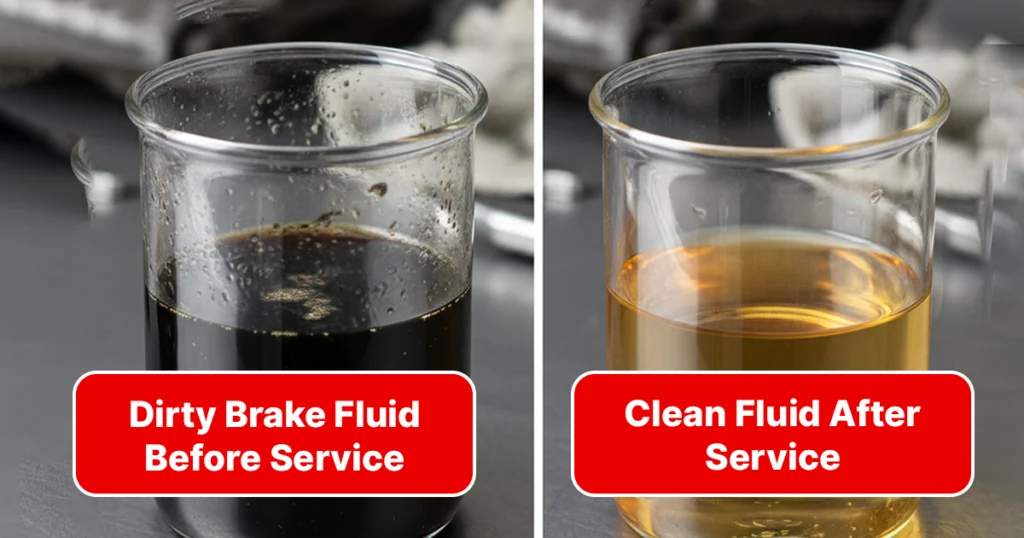When it comes to staying safe on the road, your brakes are one of the most important systems in your car. A key part of keeping them in good shape is knowing what your brake fluid should look like. Fresh brake fluid is usually clear to light yellow, but as it ages, it turns darker brown or even black, which is a clear sign it’s time for a change.
At our auto repair shop, we’ve noticed that when brake pads are worn, the brake fluid often looks darker too. If you’ve started to notice darker fluid or reduced braking performance, you might need a brake repair that includes changing your brake fluid. In this blog, we’ll explain what brake fluid should look like, what different colors mean, and when it’s best to see a professional.
If you’re searching for ‘auto repair near me,’ we’re here to help — book your service today.
What Color is Brake Fluid Supposed to be?
Fresh brake fluid is typically clear with a light yellow or amber tint. It should look transparent, almost like cooking oil. That clarity tells you the fluid is clean and healthy. There are some exceptions. Specialty brake fluids, like DOT 5 silicone-based fluid, can look purple or even blue. But unless your car specifically requires it, your brake fluid will almost always be in the clear-to-yellow range.
Different Brake Fluid Types and Colors
Not all brake fluids are the same. DOT 3 and DOT 4 are the most common, and they usually look clear to amber. DOT 5, which is silicone-based, is often purple. DOT 5.1 is glycol-based, like DOT 3 and DOT 4, so it also looks clear to amber.
It’s important not to mix these fluids. Using the wrong type can damage your braking system. If you’d like to learn more about the different types of brake fluid, make sure you check your car’s manual or talk to a mechanic before topping it off.
Here’s the breakdown:
- DOT 3: Clear to amber in color
- DOT 4: Clear to amber in color
- DOT 5: Purple in color
- DOT 5.1: Clear to amber in color
Why Does Brake Fluid Change Color?
Brake fluid doesn’t stay clear forever. As it ages, it picks up moisture from the air and can collect dirt or tiny bits of rust from inside the braking system.
All of this contamination changes the way it looks. On top of that, the high heat created when braking causes the fluid to break down, which makes it turn dark. That’s why old fluid often looks brown or black compared to the clean, clear look of new fluid.
What do Different Brake Fluid Colors Mean?
Brake fluid is one of the most vital components in your vehicle’s braking system, transferring force from your pedal to the brakes themselves. Over time, its condition can change due to heat, moisture, and contamination, all of which affect braking performance. The color of your brake fluid is a quick visual clue to its health and whether it needs replacing.
Clear to Light Yellow (Good Condition)
Fresh brake fluid typically appears clear to light yellow. This means it’s in great condition, free of contaminants, and functioning at peak efficiency. Maintaining this color ensures consistent braking performance and optimal safety on the road.
Dark Brown or Black (Bad Condition)
When brake fluid turns dark brown or black, it’s a sign of aging and degradation. The fluid has absorbed moisture and debris, reducing its effectiveness. Continuing to drive with old brake fluid can cause a soft pedal feel and dangerously reduce braking power.
Cloudy or Milky Fluid
A cloudy or milky appearance indicates that water or other contaminants have entered the brake fluid. This contamination drastically lowers its boiling point, increasing the risk of brake fade or failure during heavy use. The fluid should be flushed and replaced immediately to prevent damage.
Green or Blue Fluid
Some vehicles using DOT 5 silicone-based brake fluid may naturally have a green or blue tint, which is perfectly normal. However, if your system isn’t designed for DOT 5 and you see these colors, it could mean the wrong fluid was added or there’s cross-contamination. In that case, a full brake system flush is necessary.
When To Change Brake Fluid?
Most manufacturers recommend changing brake fluid every 2–3 years, or about 30,000 to 45,000 miles. But color can give you a good visual clue, too. If it looks dark, dirty, or cloudy, it’s time to replace it, even if you haven’t hit the mileage yet. Using the schedule and checking the fluid’s appearance together is the best way to make sure your brakes stay reliable.
Key Takeaways:
- Replace brake fluid every 2–3 years or 30,000–45,000 miles.
- Check color regularly—dark or cloudy fluid means it’s time to change.
- Fresh fluid should be clear to light amber.
- Regular changes prevent corrosion and maintain braking performance.
- Follow both mileage and visual checks for the best results.
Stay safe with regular brake maintenance
To recap, new brake fluid should be clear to light yellow, while old fluid turns dark brown or black. If it’s cloudy, contaminated, or the wrong color, it’s time to get it checked.
Remember, color is just one warning sign. Regular maintenance is the best way to keep your brakes working when you need them most. The NHTSA recommends checking all essential fluids regularly, and brake fluid is no exception. If you notice dark or cloudy brake fluid, schedule a brake inspection at Eric’s Car Care or reach us at 713-667-9293. It’s a simple step that could make all the difference in an emergency stop.

